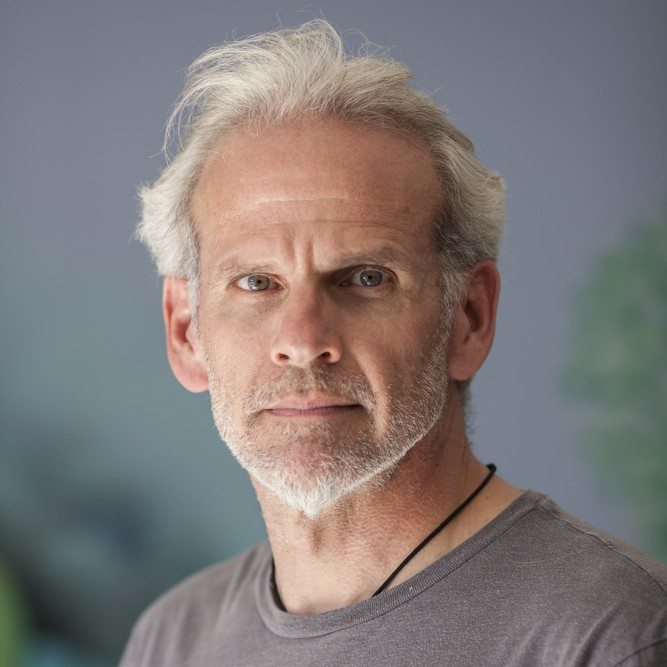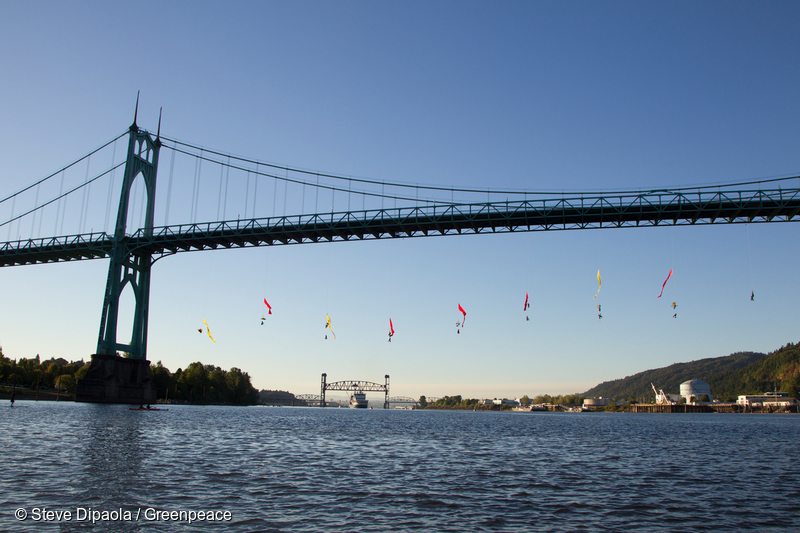On July 29, 2015, Greenpeace climbers suspended themselves from St. Johns Bridge in Portland, Oregon to block a Shell Oil vessel headed to supported the company’s Arctic drilling plans. Mark Floegel was there, and his job was to talk to the police.

Four lanes of traffic—honks, waves, fingers in the shape of a ‘v’ for peace or victory. Cars stop for a moment as hands reach out with bags of fruit and water, five blessed ten-pound bags of ice in the triple digit heat. One car makes several passes, homemade signs reading “Thanks” and “Peace” taped to the side, the shining face of a young girl—the artist, I guess—appearing in the backseat passenger window. I don’t know who you are but thank you, thank you.
You kept our spirits high.
I spent two days last month on the deck of the St. John’s bridge in Portland, Oregon, 200 and some odd feet above the Willamette River. Thirteen of my colleagues were supporting 13 other colleagues suspended from ropes, blocking a Shell Oil icebreaker—the Fennica—from leaving Portland for Arctic waters. There, it’s needed to assist Shell’s insane attempt to despoil the Arctic and oil that will bring us toward the brink of climate catastrophe.
My job was to talk to the police. Any officers I spoke with kept returning to the same question: “Why would anyone take such a crazy risk?” Stepping off a bridge, hanging by a thin line—one mistake could mean sudden, certain death.

The Shell-leased icebreaker MSV Fennica approaches the St. Johns Bridge, where climbers under the bridge are attempting to prevent the Fennica from passing under the bridge to join Shell’s Arctic drilling fleet.
The creed of the nonviolent warrior bids us to accept the risk of injury or death onto ourselves so others may be spared. Global warming is here; it can no longer be avoided. How bad things get—not just for our children and grandchildren but for all of us right now—will be determined by the choices we make today. If risking a fall means avoiding worsening climate change, it’s a small price indeed.
Global warming is here; it can no longer be avoided. How bad things get—not just for our children and grandchildren but for all of us right now—will be determined by the choices we make today.
Why anyone would take such an insane risk may be the right question to ask, but don’t ask the climbers dangling above the river, their beautiful streamers floating in the summer wind. Don’t even ask the oil executives; their motive (money) is clear. Ask President Obama; he’s the one who should be stopping Shell, not Greenpeace. A representative of the U.S. Coast Guard who visited me on the bridge deck made explicit what I’ve suspected for some time when he said to me: “We’re not on the same side.”
Greenpeace is on the side of the kayaktivists, of those who want to leave Arctic oil beneath the ground and seabed, and those who realize we must draw our fossil fuel burning era to a close.
The Coast Guard and the rest of the executive branch of the federal government are proving—repeatedly—that they are on the oil companies’ side, not ours. Mr. President, it’s you who should answer the question about risk and insanity. Global warming is a certainty, not a risk. Allowing Shell to drill the Arctic will make it exponentially worse.
Why, sir, are you doing such an insane thing to us all. Why?
Mark Floegel is the research director for Greenpeace USA and served as the police liaison during a July 29, 2015 blockade of a Shell Oil vessel.
